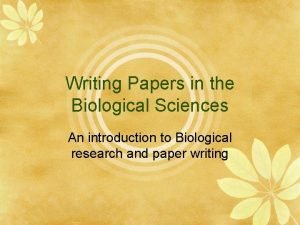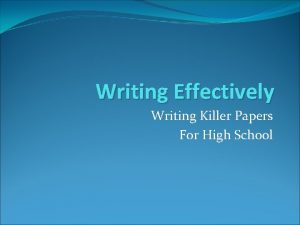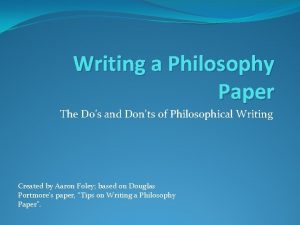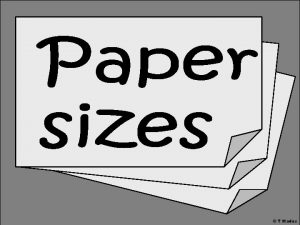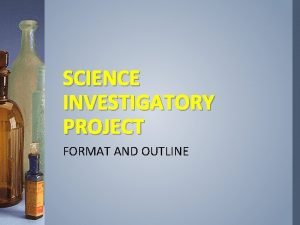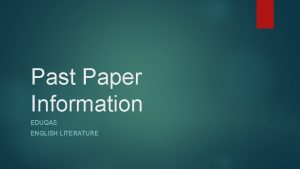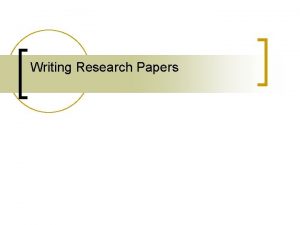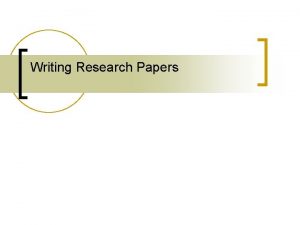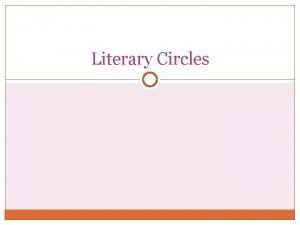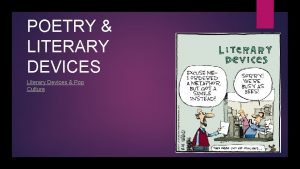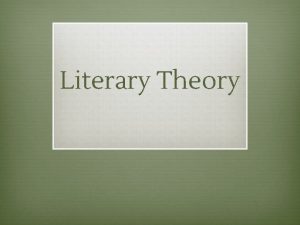Literary Analysis Papers Literary Analysis Papers A literary















- Slides: 15

Literary Analysis Papers

Literary Analysis Papers • A literary analysis is not a plot summary! • A literary analysis paper presents an arguable interpretation of a specific aspect of a literary work or works. • Support for a literary analysis argument should be drawn primarily from analysis of specific evidence from the text.

Thesis statements for literary analysis • Define an arguable interpretive thesis for your literary analysis paper. EXAMPLE: In Stephen Crane’s short story “The Open Boat, ” the four shipwrecked characters develop a personal bond that both changes and sustains them. • The thesis could be supported by evidence from the text of the story. • It is arguable in the sense that another reasonable reader could disagree with it.

Maintain focus on interpreting the literary work • A literary analysis paper does NOT assert a general truth about life or human nature based on or inspired by the literary work. So avoid defining a thesis like this one: Bonds developed between people during times of crisis can be the most enduring. • A superior literary analysis goes beyond the obvious to identify hidden patterns in the work and to point out aspects of the work that a casual reader would likely miss.

Evidence for literary analysis • Evidence for a literary analysis paper consists primarily of close readings of specific examples from the text. EXAMPLES: • The four characters in “The Open Boat” seem unnerved by the sight of the gulls, and they react to them with hostility. The oiler calls one bird an “ugly brute” while the cook and correspondent swear “darkly” at it (249). • The bars on the windows of the narrator’s room suggest that she is a prisoner who cannot escape (309). Do not use personal experiences as evidence for a literary analysis paper! N. B. Notice the in-text citations (page numbers enclosed in parentheses) follow both quoted material and paraphrased or summarized specific references to the text.

Incorporating quotes Always introduce your quotes and/or blend them into your text. Do NOT “drop” full quoted sentences into your paragraphs without signaling to your reader that what follows is a quote. EXAMPLE OF A CORRECTLY INTEGRATED QUOTE: • The narrator is initially repelled by the wallpaper. She describes it as “a dull yet lurid orange in some places, a sickly sulphur tint in others” (309). EXAMPLE OF A DROPPED QUOTE: • The narrator is initially repelled by the wallpaper. “It is a dull yet lurid orange in some places, a sickly sulphur tint in others” (309).

How much should I quote? • Most literary analysis papers rely on some direct quotes from the literary work to develop and support the writer’s interpretation. However, it’s a good rule of thumb to keep quoted material to no more than 15 -20% of the paper (some instructors recommend no more than 10% quotes). • To keep to the 15% maximum, for every line and a half of quoted material you include, you need to write eight and a half lines of unquoted material to justify it. • Think of putting yourself on a quote budget as you write. Quote only what is absolutely necessary. Quote only when the specific words are essential to your point. Trim your quotes to just what you need to make your point. When you quote sparingly, your quotes will have much more impact.

How can I support my argument convincingly with just a few short quotes? • Paraphrase and summarize! • If your point is that the character hid her writing from her husband sister-in-law, you can describe these events in your own words. You don’t have to quote to present evidence from the text.

Secondary Sources • Some literary analysis essays use material from secondary sources to deepen and enrich their arguments. • While some research essays might make use of historical or biographical information, for interpretive arguments, look for literary criticism articles published in academic journals. Do not use study guides, summaries, or book reviews as sources for literary analysis papers. • Reliable academic sources are most easily located by searching the campus library databases or Google Scholar (www. scholar. google. com).

Introducing secondary sources When you use secondary sources, introduce the source’s author, title, and publication, (especially if they are impressive) (1) to demonstrate clearly that you are giving appropriate credit and not trying to pas off the ideas of others as your own and (2) to enable your reader to evaluate the credibility and potential bias of your sources. Here is an example: • In “The Reading Habit and ‘The Yellow Wallpaper, ’” published in the journal American Literature Barbara Hochman argues, “The wallpaper has neither words nor pages. Perhaps that is why it has so often been seen as an image of the narrator’s life, never as an analog of Gilman’s writing, or of other fictional works. Still, the narrator ‘follows’ the paper as if it were a story with a plot” (91 -2).

Introducing secondary sources Without a clear introduction of the secondary source, the use of source material can be confusing, as in the example below. • The wallpaper symbolizes the narrator’s life, but it can also be viewed as representing a text to be read. “The wallpaper has neither words nor pages… Still, the narrator ‘follows’ the paper as if it were a story with a plot” (Hochman 91 -2). Remember, you need not agree with your secondary sources. Arguing against another reader’s interpretation can be an effective way to define and clarify your own argument.

Conventions of literary analysis papers: Audience • For most college papers, you should think of your audience as your fellow classmates. • For a literary analysis paper, you can assume that your reader is familiar with the work you are analyzing but is not an expert on it. • Since the reader has read the literary work, there’s no need to present a detailed summary, but when you discuss specific examples, present them with enough context that a careless or forgetful reader would still understand them, and of course, thoroughly explain how all examples relate to and support your thesis.

Conventions of literary analysis papers: Use the present tense • Although many literary works are written in the past tense, it is conventional to describe actions in a fictional work in the present tense. • One way to make sense of this is to remember that whether we read a story today, tomorrow, or ten years from now, the same action is occurring; it’s occurring in a sort of eternal present. CORRECT: The narrator hides her journal from her husband sister-inlaw. INCORRECT: The narrator hid her journal from her husband sister-in-law.

Conventions of literary analysis papers: Avoid attributing motive to the author • When we analyze a literary work, we are free to interpret the text in any way we want as long as we can develop an interpretation that makes sense. We are not bound by what the author intended, and really we can’t know what the author intended, and in a way, it doesn’t matter. • The author may not have achieved his or her goals in writing the work under analysis. • An interpretation is valid if you can make a well reasoned argument for it based on the text.

Conventions of literary analysis papers: Avoid attributing motive to the author In articulating your argument, avoid attributing motive to the author. You can usually address this with just a little rephrasing. BAD EXAMPLE: • The author is trying to show women’s creativity was stifled by the strict gender roles of the 19 th Century. IMPROVED EXAMPLE: • The text of the story demonstrates how a woman’s creativity is stifled by the strict gender roles of the 19 th Century.
 What literary device is this
What literary device is this Year 6 sats 2019
Year 6 sats 2019 Edexcel gcse art
Edexcel gcse art Writing papers in the biological sciences
Writing papers in the biological sciences Killer papers
Killer papers Transition words for philosophy papers
Transition words for philosophy papers Unit 4 criminology
Unit 4 criminology Wjec past papers law
Wjec past papers law Unit 2 health and social care level 3 past papers
Unit 2 health and social care level 3 past papers Phy 131 past papers
Phy 131 past papers Madas papers
Madas papers What type of simple machine is a stapler
What type of simple machine is a stapler Science investigatory project sample
Science investigatory project sample Gl progress test sample papers science
Gl progress test sample papers science Lucy faulkner english language
Lucy faulkner english language Eduqas a level english literature past papers
Eduqas a level english literature past papers



